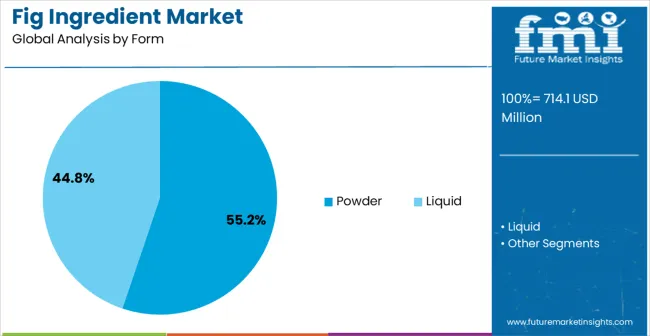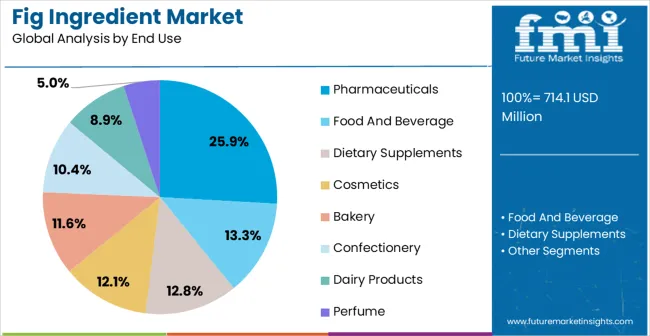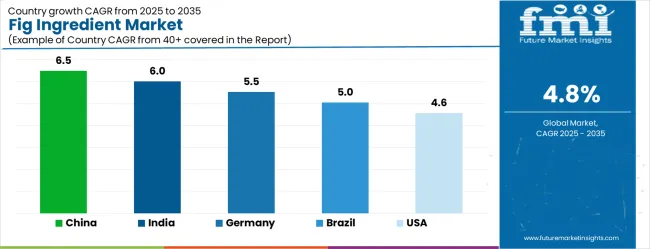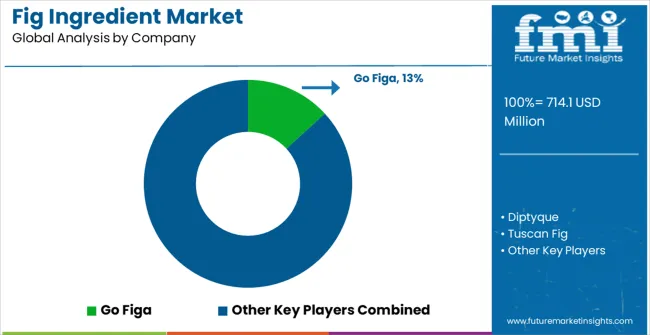The Fig Ingredient Market is estimated to be valued at USD 714.1 million in 2025 and is projected to reach USD 1141.2 million by 2035, registering a compound annual growth rate (CAGR) of 4.8% over the forecast period.
| Metric | Value |
|---|---|
| Fig Ingredient Market Estimated Value in (2025 E) | USD 714.1 million |
| Fig Ingredient Market Forecast Value in (2035 F) | USD 1141.2 million |
| Forecast CAGR (2025 to 2035) | 4.8% |
The Fig Ingredient market is experiencing steady growth, driven by increasing demand for natural and functional ingredients in food, nutraceutical, and pharmaceutical applications. Rising consumer preference for health-promoting components, such as antioxidants, dietary fiber, and bioactive compounds found in figs, is supporting adoption across multiple sectors. The market is further fueled by the expanding use of fig ingredients in dietary supplements, fortified foods, and pharmaceutical formulations due to their therapeutic and nutritional benefits.
Continuous research and development efforts are enabling extraction of high-quality fig powders and concentrates, improving functional efficacy and shelf stability. Regulatory approvals and growing awareness regarding plant-based and natural ingredients are also contributing to market expansion. Additionally, the rising focus on preventive healthcare and nutritional supplementation is driving demand from both established and emerging markets.
Investments in production capacity, processing technologies, and distribution networks are strengthening availability and accessibility As consumer health consciousness increases, the Fig Ingredient market is expected to witness sustained growth, supported by innovations in processing and formulation techniques.
The fig ingredient market is segmented by form, end use, and geographic regions. By form, fig ingredient market is divided into Powder and Liquid. In terms of end use, fig ingredient market is classified into Pharmaceuticals, Food And Beverage, Dietary Supplements, Cosmetics, Bakery, Confectionery, Dairy Products, and Perfume. Regionally, the fig ingredient industry is classified into North America, Latin America, Western Europe, Eastern Europe, Balkan & Baltic Countries, Russia & Belarus, Central Asia, East Asia, South Asia & Pacific, and the Middle East & Africa.

The powder form segment is projected to hold 55.2% of the Fig Ingredient market revenue in 2025, establishing it as the leading form. Its dominance is being driven by the ease of incorporation into various food, nutraceutical, and pharmaceutical products. Powdered fig ingredients offer extended shelf life, convenient handling, and consistent functional properties, which improve formulation efficiency for manufacturers.
The ability to standardize bioactive compounds during processing enhances quality and therapeutic efficacy, making it highly suitable for health-focused products. Powder forms are also compatible with capsules, tablets, beverages, and bakery applications, expanding their versatility. The growing demand for functional foods and plant-based supplements reinforces the adoption of fig powders.
Processing advancements, including freeze-drying and micronization, have further improved solubility and bioavailability, enhancing their performance in end products As companies focus on scalable, versatile, and high-quality natural ingredients, the powder segment is expected to maintain its market leadership, driven by convenience, functionality, and broad applicability.

The pharmaceuticals end-use segment is anticipated to account for 25.9% of the Fig Ingredient market revenue in 2025, making it the leading application area. Growth in this segment is being driven by the increasing incorporation of fig-derived compounds in nutraceuticals, dietary supplements, and therapeutic formulations. Bioactive components such as polyphenols, flavonoids, and dietary fiber are utilized for their antioxidant, anti-inflammatory, and gastrointestinal health benefits, making fig ingredients highly valued in pharmaceutical applications.
The ability to standardize active compounds and ensure consistency in quality enhances the efficacy of formulations. Rising awareness among healthcare professionals and consumers about preventive healthcare and plant-based remedies is supporting adoption.
Regulatory approvals and scientific validation of health benefits further strengthen confidence in using fig ingredients in pharmaceutical products As the focus on natural, functional, and health-promoting ingredients increases globally, the pharmaceuticals segment is expected to remain a key driver of market growth, supported by innovation in extraction, processing, and formulation methods.
The fig ingredient industry is experiencing robust growth driven by several key factors. Firstly, the rising consumer preference for natural and healthy food products is a significant driver.
Figs are recognized for their high nutritional content, including fiber, vitamins, and antioxidants, making them a popular choice among health-conscious consumers. This trend is further amplified by the increasing awareness of the health benefits associated with figs, such as improved digestion and heart health.
Secondly, the expanding application of fig ingredients in various food and beverage products is propelling industry growth. Figs are being increasingly used in a wide range of products, including bakery items, dairy products, snacks, and beverages.
The natural sweetness and unique flavor profile of figs make them an ideal ingredient for enhancing the taste and nutritional value of food and beverages. Additionally, the versatility of fig ingredients allows for innovation in product formulations, catering to diverse consumer preferences.
The growing demand for clean-label and organic products is another crucial driver. Consumers are becoming more attentive to the ingredients in their food, favoring products that are free from artificial additives and preservatives. Figs, often marketed as a natural and organic ingredient, align well with this demand, thereby boosting their market appeal.
The rise of plant-based diets is contributing to the increased use of fig ingredients. As more consumers adopt vegetarian and vegan lifestyles, the demand for plant-based ingredients, including figs, is on the rise.
The veganism trend is encouraging manufacturers to incorporate figs into plant-based and vegan products, further driving industry expansion. Overall, the fig ingredient market is poised for significant growth, fueled by health trends, versatile applications, clean-label demand, and the rise of plant-based diets.

| Country | CAGR |
|---|---|
| China | 6.5% |
| India | 6.0% |
| Germany | 5.5% |
| Brazil | 5.0% |
| USA | 4.6% |
| UK | 4.1% |
| Japan | 3.6% |
The Fig Ingredient Market is expected to register a CAGR of 4.8% during the forecast period, exhibiting varied country level momentum. China leads with the highest CAGR of 6.5%, followed by India at 6.0%. Developed markets such as Germany, France, and the UK continue to expand steadily, while the USA is likely to grow at consistent rates. Japan posts the lowest CAGR at 3.6%, yet still underscores a broadly positive trajectory for the global Fig Ingredient Market. In 2024, Germany held a dominant revenue in the Western Europe market and is expected to grow with a CAGR of 5.5%. The USA Fig Ingredient Market is estimated to be valued at USD 247.4 million in 2025 and is anticipated to reach a valuation of USD 247.4 million by 2035. Sales are projected to rise at a CAGR of 0.0% over the forecast period between 2025 and 2035. While Japan and South Korea markets are estimated to be valued at USD 37.0 million and USD 21.6 million respectively in 2025.

| Item | Value |
|---|---|
| Quantitative Units | USD 714.1 Million |
| Form | Powder and Liquid |
| End Use | Pharmaceuticals, Food And Beverage, Dietary Supplements, Cosmetics, Bakery, Confectionery, Dairy Products, and Perfume |
| Regions Covered | North America, Europe, Asia-Pacific, Latin America, Middle East & Africa |
| Country Covered | United States, Canada, Germany, France, United Kingdom, China, Japan, India, Brazil, South Africa |
| Key Companies Profiled | Go Figa, Diptyque, Tuscan Fig, Pixi Beauty, The Body Shop, Marc Jacobs, TABLE TOP GARDEN, Rutherford Meyer, Stonewall Kitchen, Newmans Own, Dairy Farmers, Rosebud Preserves Ltd, and Gippsland Dairy |
The global fig ingredient market is estimated to be valued at USD 714.1 million in 2025.
The market size for the fig ingredient market is projected to reach USD 1,141.2 million by 2035.
The fig ingredient market is expected to grow at a 4.8% CAGR between 2025 and 2035.
The key product types in fig ingredient market are powder and liquid.
In terms of end use, pharmaceuticals segment to command 25.9% share in the fig ingredient market in 2025.






Our Research Products

The "Full Research Suite" delivers actionable market intel, deep dives on markets or technologies, so clients act faster, cut risk, and unlock growth.

The Leaderboard benchmarks and ranks top vendors, classifying them as Established Leaders, Leading Challengers, or Disruptors & Challengers.

Locates where complements amplify value and substitutes erode it, forecasting net impact by horizon

We deliver granular, decision-grade intel: market sizing, 5-year forecasts, pricing, adoption, usage, revenue, and operational KPIs—plus competitor tracking, regulation, and value chains—across 60 countries broadly.

Spot the shifts before they hit your P&L. We track inflection points, adoption curves, pricing moves, and ecosystem plays to show where demand is heading, why it is changing, and what to do next across high-growth markets and disruptive tech

Real-time reads of user behavior. We track shifting priorities, perceptions of today’s and next-gen services, and provider experience, then pace how fast tech moves from trial to adoption, blending buyer, consumer, and channel inputs with social signals (#WhySwitch, #UX).

Partner with our analyst team to build a custom report designed around your business priorities. From analysing market trends to assessing competitors or crafting bespoke datasets, we tailor insights to your needs.
Supplier Intelligence
Discovery & Profiling
Capacity & Footprint
Performance & Risk
Compliance & Governance
Commercial Readiness
Who Supplies Whom
Scorecards & Shortlists
Playbooks & Docs
Category Intelligence
Definition & Scope
Demand & Use Cases
Cost Drivers
Market Structure
Supply Chain Map
Trade & Policy
Operating Norms
Deliverables
Buyer Intelligence
Account Basics
Spend & Scope
Procurement Model
Vendor Requirements
Terms & Policies
Entry Strategy
Pain Points & Triggers
Outputs
Pricing Analysis
Benchmarks
Trends
Should-Cost
Indexation
Landed Cost
Commercial Terms
Deliverables
Brand Analysis
Positioning & Value Prop
Share & Presence
Customer Evidence
Go-to-Market
Digital & Reputation
Compliance & Trust
KPIs & Gaps
Outputs
Full Research Suite comprises of:
Market outlook & trends analysis
Interviews & case studies
Strategic recommendations
Vendor profiles & capabilities analysis
5-year forecasts
8 regions and 60+ country-level data splits
Market segment data splits
12 months of continuous data updates
DELIVERED AS:
PDF EXCEL ONLINE
Fighter Aircraft Market Size and Share Forecast Outlook 2025 to 2035
Ingredients Market for Plant-based Food & Beverages Size and Share Forecast Outlook 2025 to 2035
Firefighter Tapes Market Size and Share Forecast Outlook 2025 to 2035
Firefighting Foam Market Size and Share Forecast Outlook 2025 to 2035
Firefighting Drone Market Size and Share Forecast Outlook 2025 to 2035
Bean Ingredients Market Size and Share Forecast Outlook 2025 to 2035
Milk Ingredients Market Analysis - Size, Share, and Forecast Outlook 2025 to 2035
Malt Ingredients Market Analysis by Raw Material, Product Type, Grade, End-use, and Region through 2035
Pulse Ingredient Industry Analysis in Japan Size and Share Forecast Outlook 2025 to 2035
Pulse Ingredient Industry Analysis in Western Europe Size and Share Forecast Outlook 2025 to 2035
Pulse Ingredient Industry Analysis in Korea Size and Share Forecast Outlook 2025 to 2035
Aroma Ingredients Market Size and Share Forecast Outlook 2025 to 2035
Fresh Figs Market Size and Share Forecast Outlook 2025 to 2035
Paint Ingredient Market Size and Share Forecast Outlook 2025 to 2035
Dairy Ingredients Market Size and Share Forecast Outlook 2025 to 2035
Pulse Ingredients Market Analysis – Size, Share, and Forecast 2025 to 2035
Halal Ingredient Market Analysis - Size, Growth, and Forecast 2025 to 2035
Smoke Ingredients for Food Market Analysis - Size, Share & Forecast 2025 to 2035
Cheese Ingredient Market Size and Share Forecast Outlook 2025 to 2035
Bakery Ingredients Market Analysis - Size, Share, & Forecast Outlook 2025 to 2035

Thank you!
You will receive an email from our Business Development Manager. Please be sure to check your SPAM/JUNK folder too.
Chat With
MaRIA